Break a Sweat With This Joint Friendly, Low-Impact, HIIT Workout
Medically reviewed by Kristin McGee, CPT
High-intensity interval training (HIIT) is an efficient way to fit physical activity into a busy schedule. However, if you have joint pain or are concerned about your fitness level, low-impact workouts are generally safer. Even if you routinely perform higher-impact workouts, adding low-impact training sessions can help prevent excessive wear and tear on your body and promote recovery.
High-impact HIIT exercises, such as box jumps and plyometric lunges, are excellent for building cardiovascular and bone health, but they can overwork your joints or exacerbate existing joint pain. Plus, higher-impact movements may be too challenging for anyone new—or returning to—exercise. Instead, choose low-impact exercises to avoid sudden movement, jarring, jumping, or other impactful forces on your body. Doing so can help you create a challenging HIIT workout without the risks.
Benefits of Low-Impact HIIT
Improved cardiovascular health: Low-impact HIIT challenges your heart and lungs, enhancing your cardiovascular system. This type of workout can help lower blood pressure and improve heart health, contributing to a stronger, more efficient heart.
Increased calorie burning: Despite low impact, these workouts are high intensity, which means they're great for burning calories during and after the session. The dual metabolic process of aerobic and anaerobic metabolism leads to efficient energy use and fat burning, helping to reduce abdominal fat and improve insulin sensitivity.
Better overall fitness without straining the joints: Low-impact HIIT minimizes the stress on your joints, making it ideal for people with joint-related issues, arthritis, or those recovering from injury. It's also beneficial if you want to avoid the high-impact stress associated with traditional HIIT workouts.
Enhanced metabolic health: Engaging in low-impact HIIT can make your body more efficient at delivering oxygen to your muscles, improving your metabolic health. This efficiency can lead to better performance in all of your workouts and activities.
Psychological benefits: Beyond the physical benefits, low-impact HIIT can also offer psychological advantages, such as reducing stress levels, improving overall well-being, and contributing to a healthier lifestyle.
Warm-Up (5-10 Minutes)
Starting your workout with a warm-up helps prepare your body for the intense exercise to come. A good warm-up will help prevent injury and boost your performance by activating your central nervous system, increasing your body temperature, and promoting metabolic changes.
This preparation phase gives your muscles and tendons a chance to become more pliable, reducing muscular stiffness and improving your joints' range of motion. Remember, the goal is to activate your muscles and joints gently, so adjust the intensity and range of motion as needed to suit your comfort level and abilities. Here are some activities to include.
Light Cardio
Perform some light cardio to get your blood pumping and warm up your legs, hips, and arms.
Marching in Place
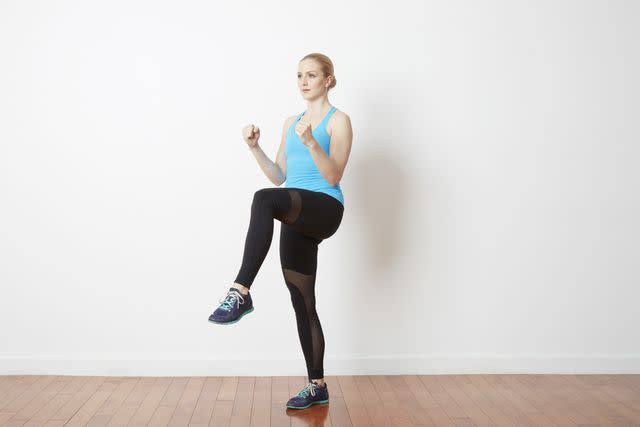
Verywell Fit
Begin by standing tall with your feet hip-width apart.
March in place by lifting your knees high toward your chest, alternating legs steadily.
Keep your arms moving in opposition to your legs to engage your upper body.
Step Jacks With Arm Raises
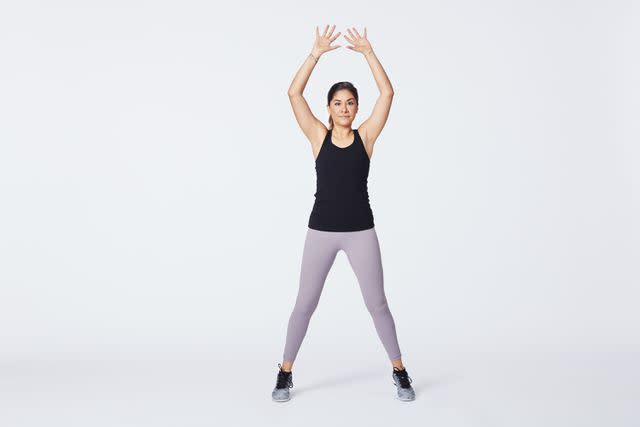
Verywell Fit
Start with your feet together and hands by your sides.
Step one foot out to the side and raise your arms, then step back to the center and repeat on the other side.
Simulated Jump Rope With Arm Circles
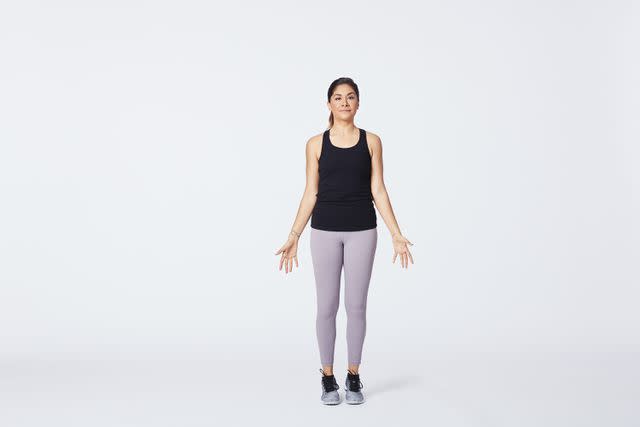
Verywell Fit
Pretend to jump rope by simulating the rope-turning motion with your arms and hopping gently on the spot.
For an even gentler version, eliminate the jump and perform arm circles while standing on your toes and then switch to your heels.
Dynamic Stretches
Active, dynamic stretches work best for warming up your body and activating the nervous system. Try the following movements and stretches.
Arm Circles (Forward and Backward)
Stand tall with your feet shoulder-width apart and extend your arms to the sides at shoulder height.
Perform small circles with your arms, gradually increasing the size of the circles.
Reverse the direction of the circles after 30 seconds.
Gate Opener
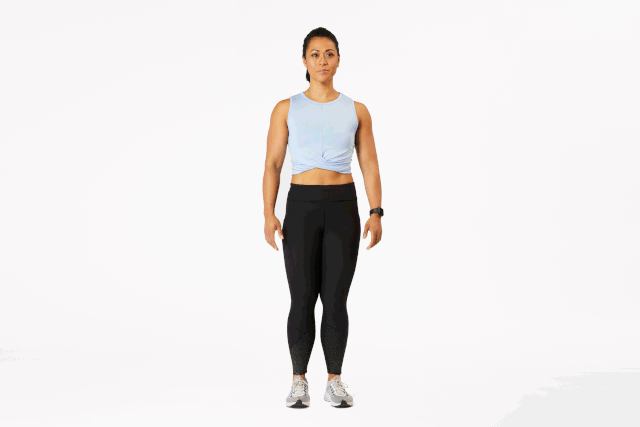
Verywell Fit
Begin standing with your feet hip-width apart.
Shift your weight to one leg and lift the opposite knee toward your chest.
Open your hip by moving the lifted knee to the side, bring it back, and lower your foot to the ground.
Repeat on the other side.
Perform 10 repetitions on each side.
Inchworm
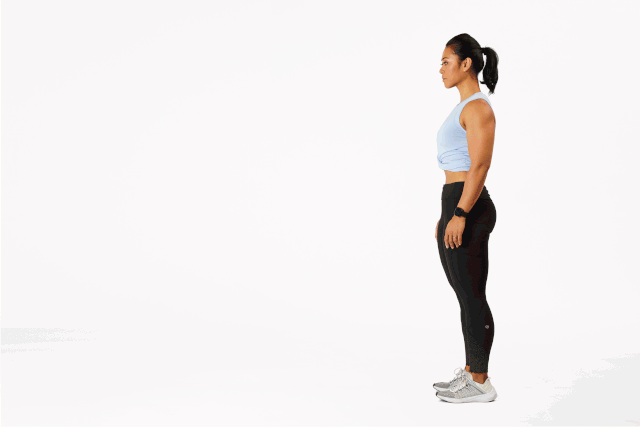
Verywell Fit
Stand with your feet hip-width apart.
Hinge at your hips and place your hands on the ground.
Walk your hands forward until you reach a plank position, keeping your legs straight.
Walk your hands back toward your feet and return to standing.
Repeat 10 times.
HIIT Workout (20-30 Minutes)
This low-impact workout will elevate your heart rate, challenge your muscles, and maximize your workout efficiency through high-intensity interval training (HIIT). By alternating between periods of intense activity and brief rest, you'll work hard but have moments of rest, each of which you can adjust to your fitness level.
Takeaway
This HIIT workout uses a work-to-rest interval format. If you are a beginner or looking for a less intense session, consider starting with 30 seconds of work followed by 30 seconds of rest. As your endurance improves, you can try a more challenging ratio, like 40 seconds of work to 20 seconds of rest. Listen to your body and adjust as needed.
Complete each exercise for your chosen work period, then rest for your designated rest time before moving on to the next exercise. Repeat the entire circuit two to three times, depending on your fitness level and time constraints.
Remember, the key to HIIT is intensity, so push yourself during the work periods while maintaining good form.
Circuit 1
Takeaway
Mountain climbers
Squats with arm raise
High knees
Mountain Climbers
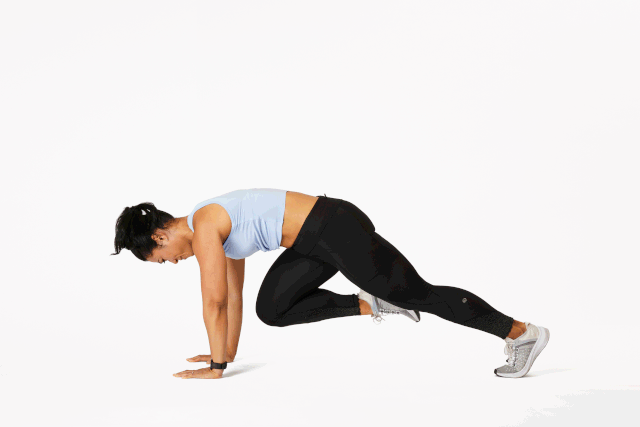
Verywell Fit
This dynamic exercise engages your core, legs, and shoulders and is a fantastic way to kickstart your circuit with energy.
Begin in a plank position, evenly distributing your weight between your hands and toes.
Keep your hands shoulder-width apart, your back flat, your abs engaged, and your head aligned.
Drive your right knee toward your chest as far as possible, then quickly switch legs, bringing the other knee in.
Maintain your hips in a low position and alternate your knees as quickly as possible, breathing in and out with each leg change.
Squats with Arm Raise
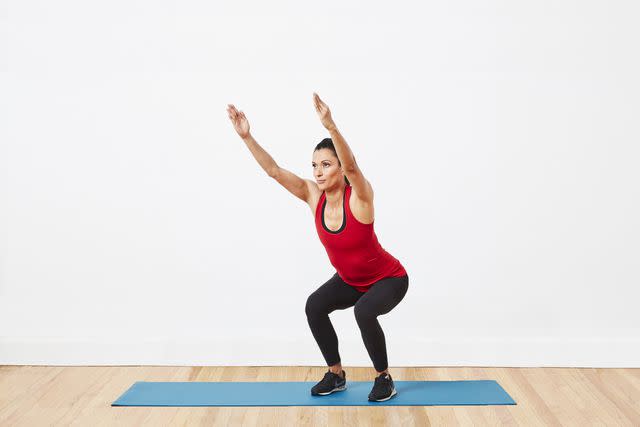
Verywell Fit
This exercise targets your quads, glutes, and shoulders, making it a comprehensive movement for building strength.
Stand with your feet hip- or shoulder-width apart, engaging your core.
Bend your knees to lower into a squat, sending your hips back as if sitting in a chair. Keep your head up and torso straight.
Raise your arms simultaneously in front of you at shoulder height.
Ensure your knees don't go beyond your toes.
Pause at the bottom, then contract your glutes to lift yourself out of the squat while lowering your arms back to your sides.
High Knees
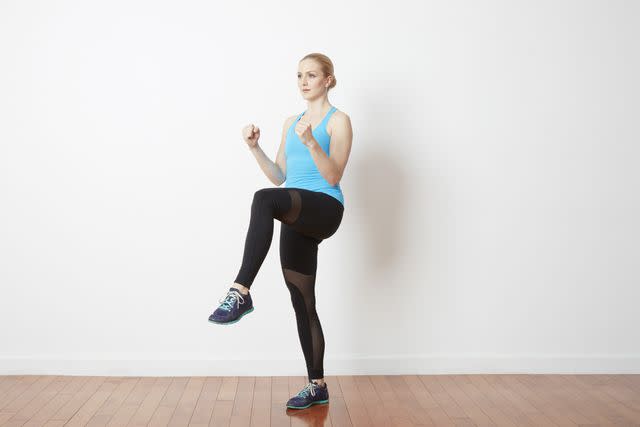
Verywell Fit
This exercise is excellent for increasing your heart rate while working your core and legs.
Stand with your feet hip-width apart, core tight.
Lift your knees high to hip level, aiming to maintain a brisk pace.
Extend your arms in front of you at hip level, and try to touch your knees to your hands with each lift for an added challenge. Alternatively, push your arms overhead for more intensity as you continue the high knees or modify by holding your arms at your sides.
Ensure you bring your knees up toward your hands rather than lowering your hands to your knees.
Circuit 2
The second circuit of our low-impact HIIT workout will challenge your body further while still being mindful of joint health. It focuses on the lower body and core, with exercises that target your hamstrings, glutes, inner and outer thighs, and shoulders. Remember, the key to these exercises is controlled movements and maintaining proper form to maximize benefits and minimize the risk of injury.
Takeaway
Front kick lunge
Lateral lunges
Bear crawls
Front Kick Lunge
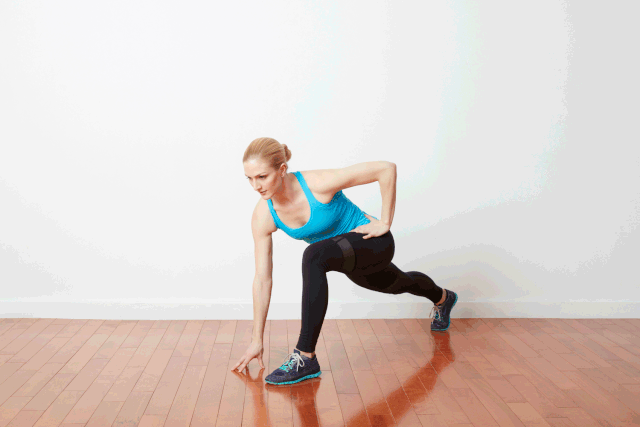
Verywell Fit
This exercise is excellent for working the hamstrings and glutes while combining balance, strength, and flexibility.
Stand with your feet about hip-width apart.
Bring your right knee up and extend your right leg out into a front kick, being careful not to lock or hyperextend the knee.
Bring your leg back quickly and immediately step it behind you into a straight-leg reverse lunge, keeping your balance on the left leg.
Lunge as low as possible, aiming to touch the floor with your fingertips.
Stand up, bring your right leg forward, and perform another kick.
Continue this sequence for one minute before switching to the other leg.
Lateral Lunges
This move targets your inner and outer thighs, glutes, and core, making it a comprehensive lower-body exercise.
Begin with your feet together.
Step out to the right, keeping both feet pointing forward.
Bend your right knee and lower your body down, ensuring your knee doesn't extend past your toes.
Push through your right heel to straighten your leg and return to the starting position.
Repeat on the left side.
Perform this exercise for a set duration on each side, focusing on depth and control with each lunge.
Bear Crawls
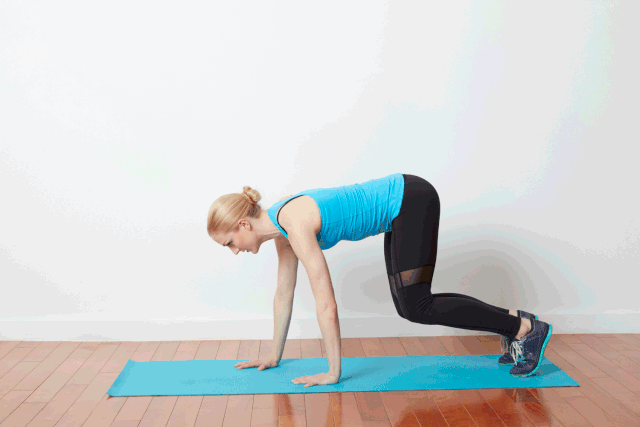
Verywell Fit
Bear crawls improve coordination and stability and strengthen the core and shoulders.
Start on all fours on the floor, with your knees under your hips and your hands under your shoulders.
Lift your knees slightly off the ground.
Move forward by stepping your right hand and left foot forward, then your left hand and right foot, maintaining a steady pace.
Keep your hips low and your core engaged throughout the movement.
Aim for 10 to 20 reps or continue for 30 to 60 seconds, depending on your fitness level.
Explainer
As you complete each exercise, focus on consistent breathing and a steady pace. Adjust the duration and intensity of each exercise to match your fitness level, being sure to challenge yourself while keeping the workout within your capabilities.
Circuit 3 (Optional Core Focus)
If you want to add an extra challenge, especially focusing on your core, this optional circuit is perfect. Strengthening your core is crucial for overall stability, balance, and fitness performance. These exercises target your abdominal muscles, obliques, and lower back, improving your core strength and stability.
Takeaway
Up-down plank
Bicycle crunches
Dead bug
Up-Down Plank
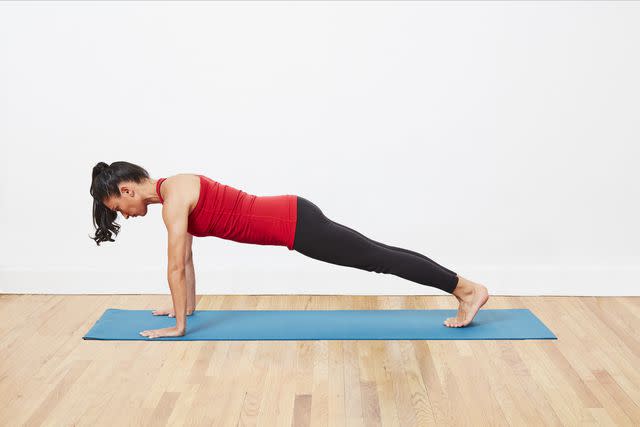
Verywell Fit
This exercise strengthens your core and challenges your upper body, including your arms and shoulders.
Start in a full plank position with your palms under your shoulders and your feet hip-width apart.
Keep your body in a straight line from head to heels.
Bend your right arm to bring the elbow and forearm to the floor, then follow with your left arm so you are in an elbow plank position.
Push back up to the starting position, starting with your right arm, then your left, to return to a full plank.
Keep your core engaged and hips as stable as possible throughout the movement.
Alternate the leading arm with each repetition to work both sides of the body equally.
Bicycle Crunches
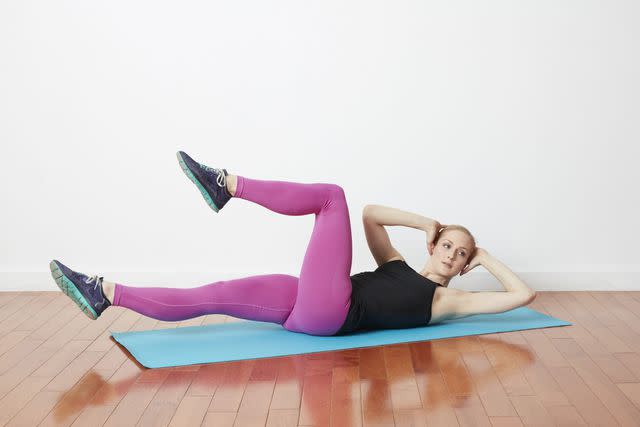
Verywell Fit
Bicycle crunches are a dynamic exercise that targets the obliques and the entire core.
Lie on your back with your hands behind your head without locking your fingers.
Bring your knees toward your chest and lift your shoulder blades off the ground.
Extend one leg out while turning your upper body toward the opposite knee, bringing your elbow toward the knee.
Switch sides, mimicking a pedaling motion.
Focus on a full rotation of the torso rather than simply moving your elbows. This exercise is excellent for engaging the deep abdominal muscles and the obliques.
Dead Bug

Verywell Fit
The dead bug exercise focuses on core strength and stability while minimizing pressure on the lower back.
Lie on your back with your arms extended straight up toward the ceiling, directly over your shoulders.
Bend your hips and knees at a 90-degree angle so your thighs are perpendicular to your body and your shins are parallel to the floor.
Extend your right arm back over your head slowly and your left leg toward the floor, keeping them straight.
Return to the starting position and repeat with the opposite arm and leg.
Keep your core engaged and your lower back pressed into the floor throughout the exercise. This movement is key for improving lower back stability and strengthening the core.
Cool Down
After an invigorating low-impact HIIT workout, it's worthwhile to conclude with a proper cool-down. Doing so helps gradually lower your heart rate, prevents muscle stiffness, and improves recovery.
When you transition your body back to a state of rest, you also reduce the risk of injury and increase blood flow, which aids in the recovery of the muscles you've just worked. A cool-down can also be a peaceful moment to reflect on your workout achievements, setting a positive tone for the rest of your day.
Walk or Pace for 60 Seconds
Begin your cool-down by walking or pacing for 60 seconds to lower your heart rate gradually and start the process of recovery. It's a simple yet effective way to transition from the high intensity of your workout to the calm of stretching and mobility work.
Static Stretches
Including some static stretches after your workout is a great way to release tension in the muscles that you've just worked. Holding each stretch for 30 to 60 seconds allows your muscles to relax and begin the recovery process. Focus on the major muscle groups you've used during your workout. Here's a list of static stretches to try:
Quad Stretch: Stand on one leg, pull your other heel toward your buttock, keeping your knees together and pushing your hip forward. Swap legs after 30 to 60 seconds.
Hamstring Stretch: Extend one leg out in front of you, toes pointing up. Hinge at the waist and lean forward, reaching toward your toes. Switch legs after holding the stretch.
Calf Stretch: Step one foot back, keeping it straight, and press the heel into the ground. Bend the front knee. Switch legs after the hold.
Triceps Stretch: Reach one hand down the center of your back, elbow pointing upward. Use your other hand to press on the elbow gently. Repeat on the other side.
Shoulder Stretch: Bring one arm across your body and use the other hand to press it into your chest. Switch arms after holding the stretch.
Butterfly Stretch: Sit with the soles of your feet together and gently press your knees down with your elbows.
Figure Four: While lying on your back, cross one ankle over the opposite knee and gently pull the thigh toward you.
Spinal Twist: Lying on your back, bring your knees to one side while keeping your shoulders flat. Switch sides after holding the stretch.
Mobility Work
Post-workout is also an excellent time to focus on mobility work, which can lead to a better range of motion and easier performance of daily activities. Mobility exercises can also enhance blood flow to your muscles and reduce the likelihood of injury. Here are some mobility exercises to incorporate.
Cat-Cow: On all fours, alternate between arching your back toward the ceiling (cat) and dipping it towards the floor (cow), moving with your breath.
Wall Angels: Stand with your back against a wall, arms raised like a snow angel. Slide your arms up and down, maintaining contact with the wall.
90-90: Sit with one leg bent in front of you at 90 degrees and the other bent behind you, also at 90 degrees. Lean forward over the front leg, then switch sides.
Lunge with a Twist: Step into a lunge and place your opposite hand next to your front foot. Twist your torso, reaching the other arm toward the sky. Switch sides.
Bottom Line
This low-impact HIIT workout combines the intensity that leads to significant health benefits with the gentleness necessary to protect your joints. It's ideal for improving cardiovascular health, burning calories, and enhancing overall fitness without having a harsh impact on your body.
For optimal results, consider performing this workout two to three times per week, with rest days in between to allow for recovery. It's important to listen to your body and modify the exercises to suit your fitness level and physical limitations.
Numerous variations of low-impact HIIT workouts are available online and in fitness apps, with plenty of options to keep your routine fresh and challenging. If you're a beginner, returning from an injury, or feel more comfortable with a joint-friendly workout option, low-impact HIIT is an ideal addition to your fitness routine.
Related: High-Impact Exercise Pros and Cons
Read the original article on Verywell Fitness.

